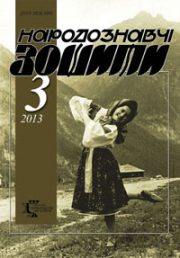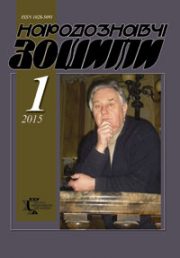The Ethnology Notebooks. 2025. № 4 (184), 956—968
UDK75.052:27-565.5]:[726:27-523.4](477.85-22)
DOI https://doi.org/10.15407/nz2025.04.956
THE PASSION CYCLE IN THE WALL PAINTING OF THE NAVE OF THE ASCENSION CHURCH IN LUZHANY
SADOVA-MANDYUK Oksana
- ORCID ID: https://orcid.org/0000-0002-3863-3482
- Ph.D., Art History lecturer,
- Iv. Trush Lviv Professional College of Decorative and Applied Arts,
- 47 Snopkivska St., Lviv, 79011, Ukraine,
- Contacts: e-mail: oksanasadova@ukr.net
Abstract. The article is devoted to the study of the frescoes of the Church of the Ascension of the Lord in Luzhany (Chernivtsi region), dating back to the 15th century. In many respects, this mural painting is consistent with the contemporary paintings of Christian churches of the Byzantine and post-Byzantine period. From the end of the 19th century, the church and its paintings were in the field of view of scientists and local historians, but it was impossible to study them comprehensively since most of the murals were whitened. In recent decades, thanks to the restoration, the possibility of their research has opened up. There are scientific articles related to the painting of the narthex, where the portrait of the founder is preserved and according to which the entire wall painting of the temple dates back to the 15th century. However, the difference between the painting of the narthex and the nave delineates at least two different periods of painting, which were performed by different groups of masters. Therefore, it is important to study the technological, iconographic, and stylistic features of the wall painting of the nave, and later the altar. This will make it possible to carry out their comparative analysis with the painting of the narthex and make it possible to clarify the periodization and dating of the wall paintings of the temple.
The wall painting of the Luzhany church has not been completely preserved. Large losses of painting and the absence of more than half of the images in the nave complicate research, especially the study of the iconographic program of the temple’s painting. Along with this, the preserved scenes, primarily of the Passion of Christ, allow us to partially understand the intention of the customers and artists of the painting. The aim of the article is to search for iconographic analogues of the Passion cycle, adapt the images to architecture, determine the ways of distribution of certain types, etc. The study is based on art historical analysis, descriptive and comparative methods.
The results of the study of the Passion cycle in the mural painting of the church in Luzhany revealed that its feature is the emphasis on the themes of sacrifice and salvation. The idea of strengthening the didactic function in the monumental Passion scenes probably belonged to the priest, who could also have been the author of the iconographic program of the altar part and the nave. The iconography of most part of compositions, which were widespread in the decoration of temples at least from the end of the 13th century, is related to the scenes of the same name in the paintings of the churches of Athos and the Macedonian school in general. The interpretations of the widespread iconographic variants («The Kiss of Judas», «The Pilate’s court», «Jesus is Laid in the Tomb») turned out to be interesting.
Keywords: Luzhany, Passion cycle, iconography, wall painting, monumental painting, murals.
Received 12.07.2025
REFERENCES
- Dan, D. (1893). Lujany. The church, the owners of the estate and its inhabitants. Chernivtsi [in Romanian].
- Romstorfer, K.A. (1899). Visual arts. The Austro-Hungarian Empire in Words and Pictures. Bukovina (Pp. 409—458). Wien [in German].
- (1913). Reports from the sessions of the Art History Committee for the period from January 1 to December 31, 1907. Reports of the Commission for the Study of the History of Art in Poland, 1—4 (Vol. 9, pp. CXXXIX). Krakow [in Polish].
- Shtefanescu, I.D. (1928). The evolution of religious painting in Bukovina and Moldavia from the origins to the 19th century (Pp. 90—91). Paris [in French].
- Balsh, G.I. (1930). Church from Lujeni. II. The introduction of the porch in the plan of Moldovan churches. ARMSI, 11. Bucharest [in Romanian].
- Grigorash, N., & Caproshu, I. (1968). Old Churches and Monasteries of Moldova (Pp. 25—28). Bucharest [in Romanian].
- Logvyn, G.N. (1982). Ukraine and Moldova. Guidebook. Leipzig [in Russian].
- (1986). Monuments of urban planning and architecture of the Ukrainian SSR (Vol. 4). Kyiv: Budivelnyk [in Russian].
- Chiobanu, C.I. (2011). The Church of Lujeni: the history of the monument research and the specifics of the iconographic program. Art Transsilvaniya, 21, 5—14. Buсharest [in Romanian].
- Dragnev, E. (2014). The iconographic program of the pronaos of the Church of the Ascension from Lujeni. School. Art. History: in honor of Tereza Sinigalia (Pp. 87—128). Petreutsi: Heruvim [in Romanian].
- Kruk, M.P. (2014). The Orthodox Church in Lujeni. School. Art. History: in honor of Tereza Sinigalia (Pp. 129—152). Petreutsi: Heruvim [in Romanian].
- (1976). Documenta Romaniae historica. A. Moldova (Vol. 2: 1449—1486). Bucharest [in Romanian].
- Millet, G. (1960). Research on the iconography of the Gospel in the 14th, 15th and 16th centuries according to the monuments of Mistra, Macedonia and Mount Athos. Paris [in French].
- Derbes, A. (1996). Picturing the passion in late Medieval Italy: narrative painting, Franciscan ideologies, and the Levant. New York: Cambridge University Press.
- Mango, C., & Hawkins E.J.W. (1966). The Hermitage of St. Neophytos and Its Wall Paintings. Dumbarton Oaks Papers, 20, 119—206.
- Dzhurych, V. (2000). Byzantine frescoes. Medieval Serbia, Dalmatia, Slavic Macedonia. Moskow: Indrik [in Russian].
- Yordanov, S. (2009). The Rock monastery of St. Archangel Michael near the village of Ivanovo. Varna: Slavena [in Bulgarian].
- Millet, G. (1927). Monuments of Athos identified with the assistance of the French Army of the East and the French School of Athens (Vol. 1). Paris [in French].
- Zarras, N. (2010). The Passion Cycle in Staro Νagoričino. Yearbook of Austrian Byzantine Studies, 60, 181—213. Wien.
- Reau, L. (1957). Iconography of Christian art (Vol. 2). Paris [in French].
- Todich, B. (1993). Staro Nagorichino. Belgrade: Srpska akademija nauka i umetnosti [in Serbian].
- Rozycka-Bryzek, A. (1968). Byzantine-Ruthenian Wall Paintings in the Swietokrzyzska Chapel in Wawel (1470). Wawel Castle Study, 3, 175—293 [in Polish].
- Todich, B. (1999). Serbian Medieval Painting: The Age of King Milutin. Belgrade: Draganich.
- Derbes, A. (1995). Images East and West: The Ascent of the Cross. The Sacred Image, East and West (Pp. 110—131, 270—279). Urbana; Chicago: University of Illinois Press.
- Schiller, G. (1972). Iconographie of Christian Art (Vol. 2). New York: Graphic society LTD.
- Zarras, N. (2016). New Testament Cycles in Middle and Late Byzantine Church Decoration. Narrating the Sacred Story. The New Testament in Byzantium (Pp. 239—275). Washington D.C.: Dumbarton Oaks.
- Epstein, Α.W. (1986). Τοkali Kilise. Tenth-century metropolitan art in Byzantine Cappadocia. Dombarton Oaks studies (Vol. 22). Washington: D.C.
- Sinkeviсh, I. (2000). The Church of St. Panteleimon at Nerezi. Architecture, Programme, Patronage. Wiesbaden: Reichert Verlag.
- Millet, G. (1910). Byzantine monuments of Mistra; materials for the study of architecture and painting in Greece in the 14th and 15th centuries. Paris [in French].
- Weitzmann, K. (1961). The Origin of the Threnos. Essays in honor of Erwin Panofsky (Vol. 1, рр. 476—490). New York: New York University Press.
- Maguire, H. (1994). Art and Eloquence in Byzantium. Princeton New Jersey: Princeton University Press.
- Hadermann-Misguich, L. (1975). Kurbinovo. St. George’s Frescoes and 12th-Century Byzantine Painting (Vol. 2). Bruxelles: Editions de Byzantion [in French].
- Kartsonis, A.D. (1986). Anastasis: The Making of an Image. Princeton: NJ.
- Weitzmann, K. (1960). Aristocratic Psalter and Lectionary. Record of the Art Museum Princeton University, 19 (1), 98—107.
- Millet, G. (1895). Mosaics of Daphni. Adoration of the Magi. Anastasis. Monuments and memorials of the Eugène Piot Foundation, 2 (2), 197—214. Paris [in French].







